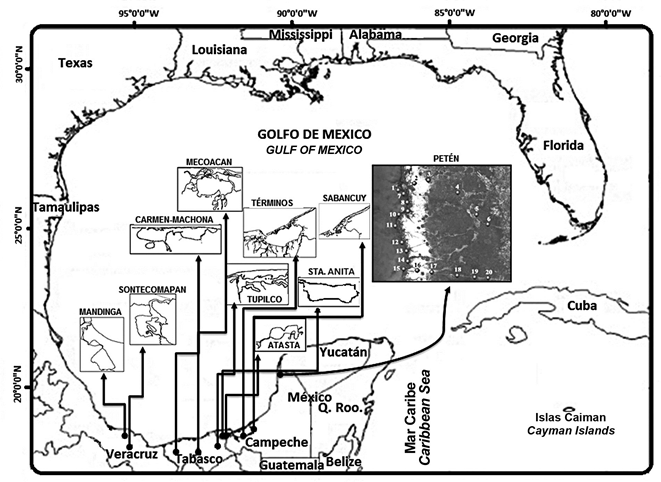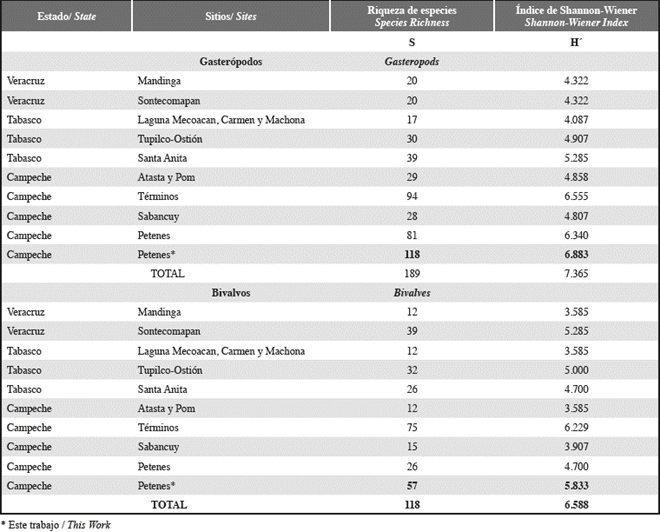INTRODUCTION
The Los Petenes Biosphere Reserve in Campeche forms a unique biogeographic unit of biological, ecological and scientific importance due to its high diversity of flora and fauna as well as to the habitats that make it up (Yáñez-Arancibia et al., 1996). Rico-Gray (1982) defined the Los Petenes region as an interrelation of environments resulting from the particular hydrology of the area, in which the karst soil of the peninsula plays a very important role. Among the habitats present in the area from sea to land, both seagrass beds, generally of Thalassia testudinum Banks ex Kóning, 1805 with Ruppia marítima Linnaeus, 1753 and Syringodium filiforme Kützing, 1860, and mangroves, composed of Rhizophora mangle Linnaeus, Avicenia germinans (L.) Linnaeus, Laguncularia racemosa (L.) C.F. Gaertn and Conocarpus erectus Kützing (Corbalá, 2004), can be characterized.
Durán (1995) performed a detailed analysis of the distribution and abundance of the vegetation of Los Petenes and concluded that there are no significant differences, i.e., that all the patterns of dominance are similar. However, the information regarding fauna in the area is generally limited, and the information that exists refers to species of commercial interest, such as mangrove oyster, octopus, snail and shrimp (Yáñez-Arancibia et al., 1996).
The only existing record containing information on mollusk ecology in the area of Los Petenes is the work of Corbalá (2004); however, some studies of nearby wetlands have been conducted. García-Cubas (1988) described the subsystems of the Términos lagoon as a function of these communities and presented taxonomic results in addition to a distribution of the species in the lagoon. García-Cubas and Reguero (1990) presented a study on the Tupilco-Ostión lagoon system that details the systematic arrangement of the lagoon, the types of nutrition and habitat; González and Torruco (2001) published a study that details the structure of the community of fishes and invertebrates in the Sabancuy estuary. García-Cubas and Reguero (1995) presented results from the Sontecomapan lagoon, and Reguero and García-Cubas (1993) published a study of the Mandinga lagoon in the State of Veracruz; both of these studies included ecological aspects of the malacological communities.
Some of the works on the malacofauna of coastal lagoons in the Los Petenes region are restricted to the gastropoda (Arellano-López et al., 2004; Juárez et al., 2004); others give records of both gastropods and bivalves (Antolí, 1979, 1986; Flores et al., 1981; Pineapple-Arce et al., 1981; Garcia, 1989; Reguero and Garcia-Vats, 1990a, 1993; Reguero, (Ortíz et al., 2009; Ruíz and López-Portillo, 2014), and others report mollusks as a group in general (Garcia-Cubas and Reguero, 1995; Quintana-Molina, 1983; Antolí and Garcia-Vats, 1985; Flores et al., 1988; Reguero and Garcia-Vats, 1989, 1990b, 1991; Garcia-Tanks and Reguero, 1990; Granados et al., 1991; Aramburu et al., 1995; Ramirez and Raz-Guzman, 2001). Most of these studies analyzed one to three lagoons, with the exception of Reguero (1994), who analyzed 11 systems: eight in Veracruz and three in Tabasco, two states neighboring the Gulf of Mexico. The present study was conducted with the dual objective of comparing the malacological fauna of the Los Petenes reserve both within their own habitats in two different years and with the fauna of six coastal lagoons of the State of Campeche, Tabasco and two Veracruz systems, as prior evidence from various studies (García-Cubas and Reguero, 1990, 1995) have considered these the most diverse coastal ecosystems for this fauna.
STUDY AREA
In 1996, Los Petenes was declared a Special Zone for Wild Aquatic Flora and Fauna by the state of Campeche, and in 1999 the federal executive decreed it a Biosphere Reserve. Located in the municipalities of Campeche de Tenabo, Hecelchakán and Calkiní, it is a narrow strip extending along the northwest coast of the state of Campeche on the Yucatan peninsula in Mexico between 20° 51' 30" and 19° 49' 00" N and 90° 45' 15" and 90° 20' 00" W and occupies an area of 3823.96 km2 (282,857 ha). It is one of the coastal wetlands in good conservation status in southeastern Mexico and has great ecological value (retention, renewal, biogeochemical transformation of nutrients and their transfer to the marine environment and adjacent coastal areas) due to the high diversity hosted by its various habitats. Because this system has habitats that are naturally fragmented and that participate in multiple interactions, the habitats within the Los Petenes reserve represent important areas for feeding, reproduction, and rest for many fauna, both resident and migratory (e.g., the Ramsar site, which forms part of the biological corridor of many species). Some species of flora and fauna are endemic, and some are under protective status at the national and even international levels. Complex systems of vegetation islands, cenotes and water eyes such as those that make up the Los Petenes reserve are only found in the Yucatan peninsula, in Cuba and in the Florida peninsula; for this reason, this region is considered a unique biogeographic area at the national level. Cervantes (2007) mentions that the triad formed by cenotes-petenes-underground rivers is an important element in water balance and also causes variations in salinity and pH. The sampling sites within the Los Petenes wetland and the coastal lagoons that were used for the comparison of the malacofauna are presented in Figure 1.
MATERIALS AND METHODS
The organisms were sampled quarterly for quantitative analysis at 20 stations in 2014. Sampling was performed using a PVC core drill of 10 cm diameter and 15 cm depth. Each sample consisted of three replicates. At each site, temperature and pH measurements were made using a YSI80 probe. One of the replicates was used to determine the granulometric fraction of the sediment, which was calculated based on the mechanical method of sieving (Secretaría de Marina, 1990). The organic matter content was determined using the ignition technique (Secretaría de Marina, 1990) by burning 3 g of dry sample. From the other replicates, the organisms were separated by passing the collected material through a 1-mm mesh screen. The collected organisms were fixed in 10% formalin solution, transferred to hermetically sealed plastic bags, and stored in labeled glass vials in a preservative solution (Warmke and Abbott, 1961; Andrews, 1971; Abbott, 1974a, 1974b; Ekdale, 1974). Once identified, they were counted and weighed, and density matrices were prepared.
The number of species and the biomass of each habitat identified for the study area were compared by one-way analysis of variance (ANOVA); ln (yi +1.5) transformation was applied to the original data to meet the assumptions of normality and homoscedasticity. When the assumptions were not met, Kruskal-Wallis ANOVA was used (Marqués de Cantú, 1998). To determine which pairs of means differed significantly, Fisher's least significant difference (LSD) post-hoc test was used (Navi, 2006). To identify the similarities in abundance and biomass of the different habitats, an analysis based on the Bray-Curtis algorithm was used, and for spatial distribution, principal coordinate analysis was employed (Pielou, 1984).
For comparison of the malacofauna of the Los Petenes reserve with that of the coastal lagoons of the region, eight lagoons were selected; Términos (García-Cubas, 1988), Sabancuy (González and Torruco, 2001), Tupilco-Ostión (García-Cubas and Reguero, 1990), Mecoacán and Carmen-Machona (Susan-Tepetlan, 2007), Sontecomapan (García-Cubas and Reguero, 1995), Mandinga (Reguero and García-Cubas, 1993) and Los Petenes (Corbalá, 2004).
Although some lagoons were investigated by different authors in different years, for the overall comparison, eight published studies were selected based on the following criteria: (1) the study covered an annual cycle; (2) the work included a presence-absence table; and (3) the number of sites investigated was close to 20. In addition, our own unpublished data for the Atasta and Pom lagoons in Campeche and the Santa Anita lagoon in Tabasco were used for comparison (Figure 1). Given the differences in sampling techniques used in the consulted works, the comparative analysis was based on a presence absence matrix, which included the mentioned localities and the data obtained in Los Petenes in the present study. Likewise, the Importance Value Index (IVI), which summarizes the proportion of each species in relation to its relative abundance, relative frequency and relative biomass (Curtis and MacIntosh, 1951), was used.
RESULTS
Over the course of the year, the temperature averaged 26.9 °C, and the pH of the sampled material averaged 8.7. Organic matter values ranging from 0.21 to 1.24 g were recorded, corresponding to 7.96% to 71.12% dry weight (Figure 2A), respectively. In the majority of the stations, sand made up the highest granulometric proportion; silt and clay had lower values (Figure 2B). During the sampling, six different habitats were identified: marine, blanquizal, popal-tular, mangrove, peten and mangrove canals. A total of 175 species and 12,850 individuals were collected.

Figure 2 Granulometric composition and organic matter content of the sites studied in the Los Petenes Biosphere Reserve.
The analysis of species richness by habitat was performed by means of a non-parametric test. Given that the assumptions for analysis of variance were not met, it was decided to use the Kruskal-Wallis ranked ANOVA; when p > 0.05 was obtained, it was assumed that there were no significant differences between the different habitats analyzed (Table 1).
Table 1 Kruskal-Wallis ranked ANOVA of species richness in Los Petenes.
| Variable Independiente : HÁBITAT / Independent Variable: HABITAT Prueba de Kruskal-Wallis / Kruskal-Wallis test: H ( 5, N= 20) = 7358410 p = 0.1954 | |||
|---|---|---|---|
| Código / Code | No. Valido / No. Valid | Suma de Rangos /Ranked Sum | |
| Zona marina / Marine area | 100 | 4 | 60 |
| Blanquizal | 101 | 4 | 51 |
| Popal-Tular | 102 | 4 | 68.5 |
| Manglar /Mangrove swamp | 103 | 4 | 45.5 |
| Peten | 104 | 4 | 20 |
| Canal de mangle /Mangrove canal | 105 | 4 | 5 |
Mangrove, mangrove canals and marine zone showed the greatest variation in the standard deviation of species richness and mollusk biomass, whereas peten, popal and blanquizal showed little variation (Fig. 3A). The marine zone, popal-tular and blanquizal have similar biomass, greater than that of peten, mangrove and mangrove canals (Figure 3B).
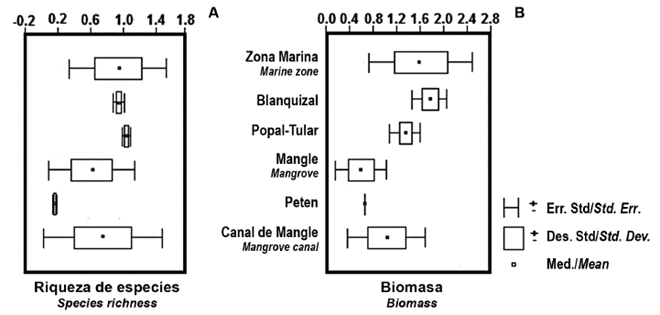
Figure 3 Basic statistics of species richness and mollusk biomass in the different habitats of the Los Petenes Biosphere Reserve.
From the analysis of variance (p < 0.05) used to study biomass by habitats, we conclude that at least one habitat is significantly different from the others (Table 2). Therefore, a post-hoc test was performed. The results show that the biomass in the marine zone is significantly different from that in the mangrove and the peten, that the blanquizal biomass is different from that of the peten and that the popal biomass is different from that of the peten (Table 3).
Table 3 LSD test for the biomass of mollusks in the Los Petenes Biosphere Reserve. (*indicates statistically significant values at p <0.005.)

With respect to the abundance of mollusks, the marine zone and the blanquizal habitat are very similar; the popal-tular and mangrove canal habitats also share in this association, and another strong similarity is presented by the peten and the mangrove (Figure 4A). The biomass shows a different pattern in which the popal-tular and blanquizal areas are tightly joined, as are the marine zone and the mangrove canals; the petenes and the mangrove are later joined to these groups (Figure 4B).
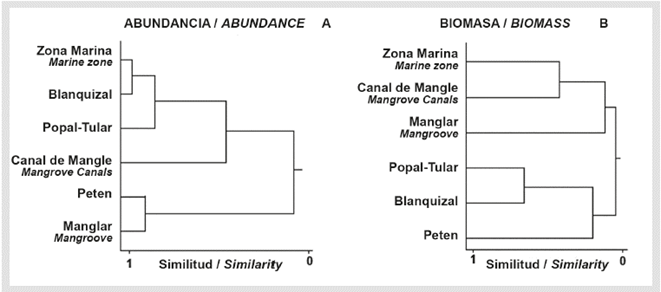
Figure 4 Assemblages of mollusk abundance and biomass in various habitats of the Los Petenes Biosphere Reserve. The figure indicating abundance showsstrong relationships among the marine zone, blanquizal and popaltular and between peten and mangrove. For biomass, the associations are weaker
Comparison with coastal lagoons
Although dominance in the gastropods is not very high, three species, representing 1.7% of all species, are the most dominant: Bulla striata Bruguiére, Cerithideopsis pliculosa (Menke) and Neritina virginea (Linnaeus). Among bivalves, two species, representing 2.6% of all species, are the most dominant: Chione cancellata (Linnaeus) and Mercenaria campechiensis (Gmelin) (Table 4).
Table 4 Dominance given by the importance value index (IVI) of the species in the lagoon and petenes systems.
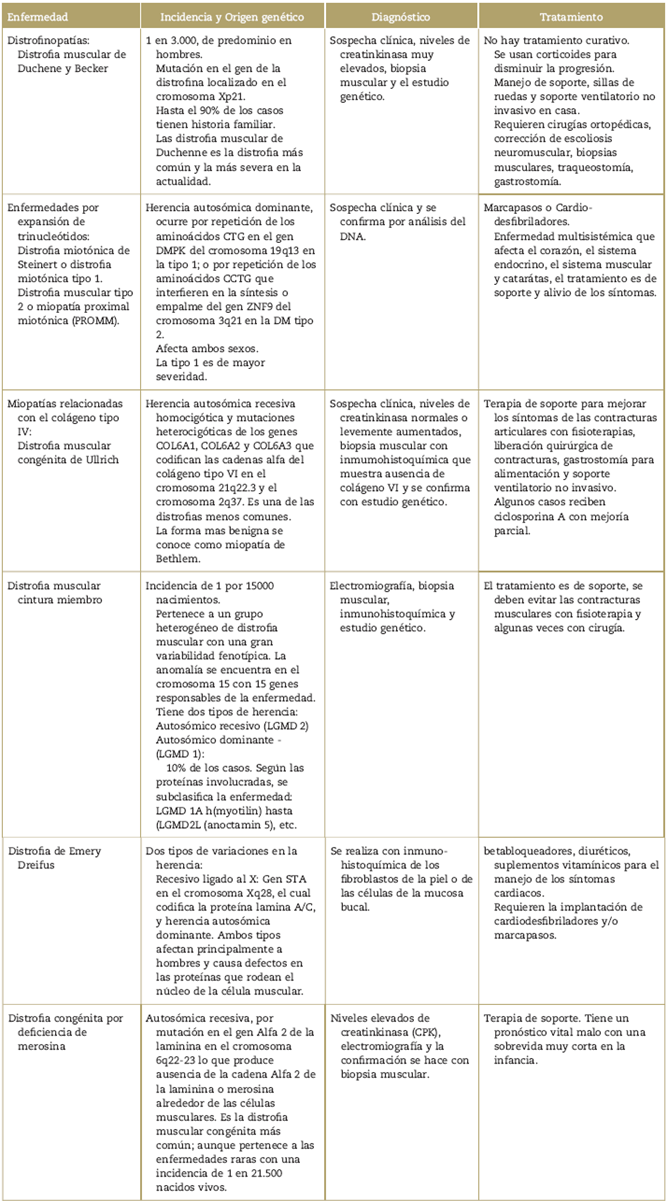
The highest species richness among gastropods was found in Los Petenes and in Términos, with 118 and 94 species, respectively. Términos presented 75 species of bivalves, whereas Los Petenes contained 57 (Table 5). Among gastropods, the greatest diversity was found in Los Petenes (6.88 beles/ind.); however, other localities also reached high values (6.55 beles/ind. in Términos). For bivalves, the highest diversity was found in Términos (6.2 beles/ind.); Los Petenes had a diversity of 5.8 beles/ind. (Table 5).
The cluster analysis shows a strong association between Atasta and Pom and Sabancuy as well as among Mecoacán, Carmen and Machona; Sontecomapan and Los Petenes show high similarity. Términos and Tupilco-Ostión show low values of similarity to the other sites (Figure 5A). The bivalves show four strong assemblages: Atasta and Pom with Sabancuy, Mecoacán, Carmen and Machona with Mandinga, Sontecomapan with Tupilco-Ostión and Petenes with Términos (Figure 5B).
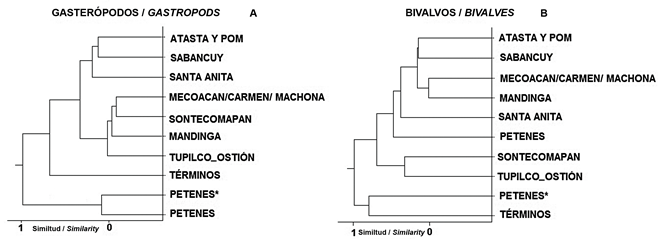
Figure 5 Assemblages of the different ecosystems in the southeast of Mexico using mollusk fauna as the descriptor. Groups of sites are formed; however, with respect to gastropods, both Petenes and Términos have very low similarity to other lagoons, denoting their identity. Bivalves show paired associations, whereas Términos and Petenes are grouped together but with low similarity.
DISCUSSION
This discussion focuses on two approaches: in the first one, the approach the different environments presented by the Petenes are compared, whereas the second approach compares the Petenes as a system with the eight coastal lagoons of the neighboring states.
Los Petenes
The Los Petenes Biosphere Reserve is a system of wetlands made up of different environments, each of which has its own individual characteristics that differentiate it from the others despite the fact that all of these environments are closely related by the hydrological characteristics that prevail in the area (Rico-Gray, 1982; Duran, 1995; Yanez-Arancibia et al., 1997). The values of temperature and pH found in the Los Petenes Biosphere Reserve in this study are within the ranges reported by CONANP (2006) for the Reserve. According to its characteristics, the system can be divided into six classes that correspond to different environments. Despite their close relationship to each other, these environments can be distinguished from each other, and each is expected to have its own attributes, including differences in the structure of its resident communities as well as in its environmental and ecological variables. This is true even when the environmental factors (temperature, pH and sedimentology) observed in each habitat do not show noticeable differences because the majority are sandy environments and the organic matter shows some heterogeneity. Although no significant differences in mollusk abundance were recorded in the different habitats, there are differences in the mollusk biomass found in the Petenes and mangrove habitats, and these differences are reflected in the LSD test; a similar result was reported by Corbalá (2004).
The analysis of habitat similarity defines the relationships that exist between the different habitats with greater precision. With respect to mollusk abundance, the marine zone and the blanquizal are very similar with respect to the large numbers of individuals present in these environments, whereas the mangrove and peten habitats both show low abundance. With respect to biomass, the popal-tular and the blanquizal, both habitats with medium-sized organisms, are very similar, whereas the marine zone and the mangrove canals resemble each other in the large size of their specimens. This association may be due to differences in the distribution of organic matter, which is the food source of many species of this group. Although some authors (Wiseman and Sturges, 1999, CONANP, 2006) mention the difference of seasons (dry and rainy) throughout the year, no differences were found in the current study, probably due to the periodicity of sampling.
Comparison with the lagoons
In comparison with other systems and with itself over time, Los Petenes as a whole viewed as a unit contained more mollusk species than the other wetlands analyzed. The lagoon system that most closely resembles it is the Términos lagoon and, in previous years, the Petén itself. Use of the Kruskal-Wallis analysis of variance as a test statistic showed that there are significant differences in the mean numbers of species present in the different ecosystems (X2 9,1-0.05).
Among gastropods, the three species with the greatest dominance were Bulla striata, Cerithideopsis pliculosa and Neritina virginea, a finding that agrees with the report of García (1989) for the Camaronera Lagoon in Alvarado (Veracruz). Other abundant species were Texadina sphinctosoma and Cingula floridanus. For the same lagoon, Reguero and García-Cubas (1989, 1990b) report the dominance of Rangia flexuosa, Neritina reclivata, Mulinia lateralis and Texadina sphinctostoma, and these same authors (1991) later report Diastoma varium as dominant.
The following species are reported as dominant for the Carmen-Pajonal-Machona lagoon system: C. pliculosa, Retusa candei and Texadina sphinctostoma among the gastropods and Rangia cuneata, Mulinia lateralis and Rangia flexuosa among the bivalves (Antolí, 1979, 1986; Antolí and García-Cubas, 1985). Piña-Arce et al. (1981) also reported the bivalves R. cuneata and R. flexuosa as common, as well as the gastropods Acteocina canaliculate and C. pliculosa.Juárez et al. (2004) reported Nassarius acutus, Phrontis vibex, C. pliculosa, N. virginea and Phos candei for the same lagoon, whereas Granados et al. (1991) reported abundance of the gastropods C. pliculosa, N. virginea, Crepidula plana, Phrontis vibex and N. acutus and the bivalves Rangia flexuosa, Donax variabilis texasiana, Rangia cuneata, Crassostrea virginica and Ostrea stentina as the most abundant species in this body of water.
For the Mecoacán lagoon, N. virginea, C. pliculosa, Neritina reclivata and P. vibex are reported as dominant (Arellano-López et al, 2004). Reguero and García-Cubas (1990a) and García-Cubas and Reguero (1990b) found the bivalves Mytilopsis leucophaeata and R. flexuosa as dominant and Acteocina canaliculata and Texadina sphinctostoma as dominant gastropods for the Tupilco-Ostión lagoon. All of these lagoons are in the state of Tabasco.
For the La Mancha lagoon in northern Veracruz, Flores et al. (1988) reported N. virginea, C. pliculosa, A. canaliculata, M. leucophaeata, Ischadium recurvum and Lucina pectinata as the most abundant mollusk species; for the same lagoon, Aramburu et al. (1995) found N. virginea, C. pliculosa, Ischadium recurvum, Crassostrea rhizophorae and M. leucophaeata to be the most widely distributed species. As seen, the high frequency of N. virginea and C. pliculosa species is widely confirmed.
For eleven coastal lagoons of the Gulf of Mexico, Reguero (1994) recorded Mulinia lateralis, T. sphictostoma, M. leucophaeata, N. virginea, A. canaliculata, R. flexuosa and N. reclivata as dominant. Although there are differences in the bivalves found in this work (Chione cancellata and Mercenaria campechiensis), the difference may be due mainly to the type of substrate; the other lagoons are characterized by higher percentages of silt and clay than those found here, demonstrating the importance of this factor.
Reguero et al. (2010) mentioned in the Campeche biodiversity book that for the state there is a total registry of 660 species of mollusks, of which 439 are gastropods and 217 are bivalves, and indicate that the Términos lagoon has a total of 166 species and 10 species for Sabancuy. For Los Petenes, Pech et al. (2010) show a figure with only 22 species. However, the authors mention that these data include marine species. This implies that the information may not have been reported accurately because it reflects a different recording effort applied to each locality; therefore, it should be regarded with caution. It is possible that this consideration can also be applied to our comparison; nevertheless, extreme care was used in selecting the eight sites that were contrasted with Los Petenes.
Taking as a case the Términos lagoon, the same authors indicate 172 species of mollusks (95 gastropods and 74 bivalves), noting that it is more diverse than the Laguna Madre in Tamaulipas and Tamiahua and Alvarado in Veracruz. In Términos, they recognize four environments: inner lagoons associated with rivers, interior lagoons that empty into the lagoon, main basin of the lagoon (25% of the total) and areas of marine influence (the latter harboring more than half of the species); in our case, the environments are given by the different habitats of the Los Petenes system.
The results of the measurement of ecological diversity give an idea of the magnitude of this community statistic in the analyzed sites; in the majority of the sites, ecological diversity was high, exceeding 3 beles/ind. The effect of the magnitude of the site on the results is also evident because the highest values corresponded to very large sites, especially those that contained a matrix of complex vegetation. According to Odum (1970), who states that "diversity is often low in physically controlled ecosystems (this is subject to strongly limiting physicochemical changes) and high in biologically controlled ecosystems", most localities must be controlled biologically; this occurs especially due to very strong interspecific relationships among species that are well adapted to the physical and chemical variations in the environment.
On the basis of the ecological similarity levels of the localities and the presence or absence of mollusk species, sites with similar hydrological regimes were assembled in dendrograms that show pairs of localities with high similarity. Some sites coalesced with lower similarities to strongly conformed groups. Both fractions of the group of mollusks showed high similarities between almost the same localities, indicating a high correspondence between the species. In any case, Los Petenes seen as a unit is the richest and most diverse wetland system in the Mexican southeast that has so far been documented in terms of mollusk fauna, supporting the view of Lohrenz et al. (1999), who referred to these systems as highly productive and dynamic environments.
Although the literature on the fauna of the Los Petenes Biosphere Reserve mentions the extraction of mangrove oysters, this activity has not been conducted since the late 1970s, according to fishermen in the area who are still living. In the areas from which the samples were collected, only one site contained areas in which the sediment appeared to have been previously disturbed, as indicated by the presence of gravel.
The present work will serve as a basis for studies aimed at a more thorough comparison using the same methodology in each site and covering an annual cycle. Such studies will make it possible to definitively demonstrate the importance of this great ecosystem and will encourage the relevant authorities to develop conservation and restoration programs for the areas containing systems that are so productive and diverse.











 texto en
texto en 

